The mid-19th century was a time of sweeping development of industry and transport systems in Europe. The growth of the railway network stimulated the expansion of trade, which led to increased competition and the need for continuous improvement of production technologies. This, in turn, required intensive scientific development. As a result, the essence of technical sciences shifted from a collection of empirical knowledge to systems of theoretical concepts based on technological advances in physics, chemistry, and mathematics. At the same time, both in Russia and in Europe, the attitude toward industry was changing. Previously, this sphere was dominated by members of the lower classes; however, by the 1850s, the nobility became interested in developing industry. As a consequence, the societal need for higher technical education emerged.
1862 - 1896
Russia's defeat in the Crimean War (1853-1856) had a stunning impact on Russian society. Feelings of pride and superiority after the victory over Napoleonic Europe gave way to a sense of insecurity. Despite a valiant effort, Russia lost the war to a coalition of Europe’s most powerful states. However, the contrast between the victory of 1812 and the defeat of 1855 demoralized Russian society, causing Russians to believe in the “backwardness” of our country and the need to “catch up” with the more developed countries in Europe. It was in such an environment that the government of Alexander II launched changes that went down in history as “The Great Reforms”.
In 1859, the Minister of Finance A.M. Knyazhevich began the transformation of the Saint Petersburg Practical Institute of Technology (SPPIT) into an institution of higher education that would offer modern technical training. His work in this area was completed by Michael von Reutern, who replaced him. The director of SPPIT at that time was the mining engineer I.P. Tchaikovsky. On July 3, 1862, a new regulation was adopted in relation to the Institute, which entered into force on August 1 of the same year. SPPIT received the status of a university. According to the new regulation, it became “a special higher-class educational institution aiming to educate skilled and knowledgeable people about technologies used in the construction of factories, manufactories, and industrial enterprises, and for the management thereof, as well as the dissemination of technical knowledge in general”.
The Institute employed professors and established its own faculty in applied physics, applied mechanics, applied chemistry, mechanical and chemical technology, and construction. The Institute's teachers enjoyed the same rights as university professors.
In the 1860s, Professor R.E. Lenz created a physics cabinet at the Institute, which became the foundation for the future Department of Physics, where the professor and his lab assistants would conduct scientific studies. During his 34 years of work at “Technolozhka”, Professor R.E. Lenz published 22 scientific papers and expanded the department. The department was referred to as the “physics cabinet” until 1912 and the “physics laboratory” until 1932. From 1918, the physics laboratory was headed by Professor N.N. Georgievsky. In 1922, the physics teachers employed at the department divided their time between the chemical and mechanical faculties. In 2016, to enhance teaching quality, the Department of General Physics was merged with the Department of Electrical Engineering and Electronics both of which followed the curricula of the latter. The main focuses of the department’s research were 1) geometric structure and molecular dynamics of organic and organoelement compounds, 2) electronic structure of molecules and the nature of chemical bonds, and 3) vibrational and microwave spectroscopy. A number of original sensors were created and developed to measure fluid flow, determine the octane number of motor fuels, and measure water content. A system for fine purification of biological products using the zone melting method was designed. A lot of work was done to study the influence of magnetic fields on blood oxygen saturation. Using the bioluminescence method, researchers investigated the effect of laser radiation on energy-saturated compositions (explosives and pyrotechnic compositions) of diseases. The department actively participates in the Grant Competition and the Federal Program curated by the Ministry of Education and Science. Today the department is headed by a Doctor of Chemical Sciences, Professor A.V. Belyakov.
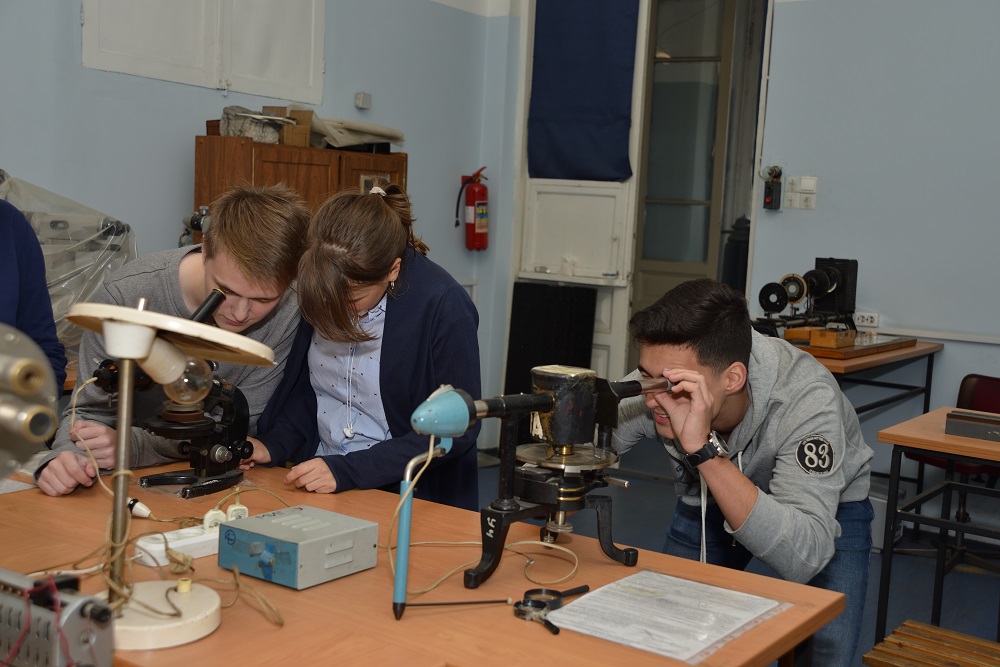
- Construction physics
- Electrical and electronics engineering
- Electrical and industrial electrical engineering
- Electrical engineering, electronics and circuit engineering
- Electronics and electrical engineering
- Fundamentals of electronics and power supply
- Fundamentals of solid-state physics
- Physics
The department was established in the 1860s as part of a new chemical laboratory where students produced a number of chemical compounds, including organic ones. From 1863, the creator of the periodic table of elements, D.I. Mendeleev, taught a course in organic chemistry and headed the chemical laboratory. In 1866, the department was headed by F.F. Beilstein, who contributed greatly to the theory of aromatic compounds. The scientist earned worldwide fame by publishing a handbook on organic chemistry that continues to be published by the Beilstein Institute in Munich. Even today, the department's research focuses on the chemistry of unsaturated compounds such as aromatic hydrocarbons and their derivatives, such as ethylenes and acetylenes. Since the arrival of Professor A.A. Petrov to the post of head of the department in 1951, the main objects of research have been highly marginal compounds. Recently, a modern Bruker Avance III HD nuclear magnetic resonance spectrometer (400 and 100 MHz) has been successfully operating at the department in the engineering center of the Institute, allowing for conducting complex experiments. Many of the compounds and intermediates synthesized recently at the department are of great interest in the areas of fine organic synthesis and medical chemistry. Employees and professors of the Department of Organic Chemistry work in the editorial offices of chemical journals. The high pedagogical and scientific potential of the department is nourished by the influx of new personnel through the department’s postgraduate program. Since 1950, more than 300 candidates of sciences have graduated from this department. Now the department is headed by a Doctor of Chemical Sciences, Honorary Worker of Higher Professional Education of the Russian Federation, Professor M.L. Petrov.
- Computer science in organic chemistry
- Fundamentals of organic synthesis
- Identification and determination of the structure of organic compounds
- Organic chemistry
- Organic chemistry and fundamentals of biochemistry
The Department was founded in 1862 under the name of the Department of Applied Mechanics. It was first headed by Professor I.A. Vyshnegradsky (who became director of the Institute in 1875). Owing to his active participation, applied mechanics was further developed as a branch of science and divided into different areas: resistance of materials, lifting machines, construction of machines, steam engines, machine parts, and the theory of elasticity. As a result of their outstanding work, luminaries in science soon started emerging from the department. Notably, a pupil of I.A. Vyshnegradsky’s scientific school, Professor V.L. Kirpichev, wrote the two classic textbooks on the “Resistance of Materials” and “Machine Parts”, which were studied by more than one generation of design engineers. In 1911, S.P. Timoshenko was invited to the Saint Petersburg Practical Institute of Technology to work at the Department. He would later become the world's leading scientist in the fields of material resistance, elasticity theory, and oscillation theory. His research papers and textbooks have been used as reference by design engineers and students to this day. The most important areas of research outlined by the founders of the Department are finding scientific foundations for the design of new chemical equipment and the development of principles for the systematic solution of problems of safe operation of modern machines and devices of chemical production. Future mechanical and chemical engineers are trained in these areas. The Department of Mechanical Engineering teaches all mechanical engineering disciplines, including theoretical mechanics, material strength, theory of mechanisms and machines, machine parts, and fundamentals of design. Obtaining outstanding results at the Department requires a highly qualified staff, quality research, and comprehensive training. The current staff at the Department ensures that these criteria are met. Today the Department is headed by a Doctor of Technical Sciences, Professor N.A. Martsulevich.
- Additional chapters of applied mechanics
- Applied mechanics
- Design of automation mechanisms
- Fundamentals of applied mechanics
- Fundamentals of design
- Machine parts
- Machine parts and design basics
- Mechanics
- Mechanics of materials and fundamentals of design
- Resistance of materials
- Technical mechanics
- Theoretical mechanics
- Theory of mechanisms and machines
The Department was founded in 1862 when, following a reorganization, the Saint Petersburg Practical Institute of Technology received the status of an institution of higher education. Teachers were recruited from among university graduates and employees of military academies, like Lev Spassky, who was a teacher of the Pavlovsky Cadet Corps. The great Russian metallurgist D.K. Chernov, who had graduated from SPPIT, worked as a teacher for three years. In 1980, the Department was divided into the Department of Higher Mathematics and the Department of Applied Mathematics. Classical sections of mathematics were taught at the Department of Higher Mathematics, and the Department of Applied Mathematics occupied itself with teaching the theory of probability, mathematical statistics, and computational mathematics. In 2012, the Departments of Higher and Applied Mathematics were merged. The Department of Mathematics was established and has since been headed by Doctor of Physical and Mathematical Sciences A.A. Gruzdkov. For more than a century and a half, the Department has employed many scientists known for outstanding achievements in various fields. Substantial efforts have been made in recent decades by the Department to motivate and prepare students for mathematical Olympiads. The Institute has participated in city and regional mathematical Olympiads since the 1970s and has consistently produced winners. Currently, the intramural stage of the mathematical Olympiad is held within the framework of the international Internet Olympiad and enjoys considerable interest among students. The most striking successes of our students are K. Monastyrsky’s victory in the Absolute Personal Championship of Saint Petersburg and the two silver medals won in the final round of the I. Demidov Internet Olympiad. Today, the Department is headed by Doctor of Physical and Mathematical Sciences A.A. Gruzdkov.
- Additional chapters of mathematics
- Algebra and geometry
- Functional analysis
- Higher mathematics
- Mathematical analysis
- Mathematics
The Department was established from 1861 to 1863 during the formation of the departmental structure of the Institute. During those years, lectures on descriptive geometry began. At the turn of the 19th and 20th centuries, graphics disciplines at the Institute were taught by the outstanding specialists E.E. Baumgarter (architectural drawing) and A.A. Voronov (design). In 1897, I.M. Kholmogorov who taught drawing, design, and descriptive geometry, started working here. His book “Machine-building Sketching” went through 12 editions. The first post-revolutionary years were the hardest in the history of the Department. Its potential was restored to a high level under the leadership of Candidate of Technical Sciences, Professor D.G. Ananov who headed the staff of lecturers from the 1930s to 1945. D.G. Ananov was a remarkable specialist and professor. The method of conditional scans used in the constructions of intersection lines of faceted surfaces was named after him. D.G. Ananov is also known as the author of the “Course of Descriptive Geometry”, which went through six editions. In the early 1970s, the Department received its modern name of the “Department of Engineering Design”. During this period, the training of future specialists in construction and design was upgraded. The main research areas lately have been the design of facilities for wastewater treatment and gas emissions. In addition, the Department has developed software and created module databases and libraries for computer-aided design of chemical and technological installations. Recently, the Department of Engineering Design has modernized the training of future specialists in both graphics and design. Today, the Department is headed by Doctor of Technical Sciences, Professor M.A. Yablokova.
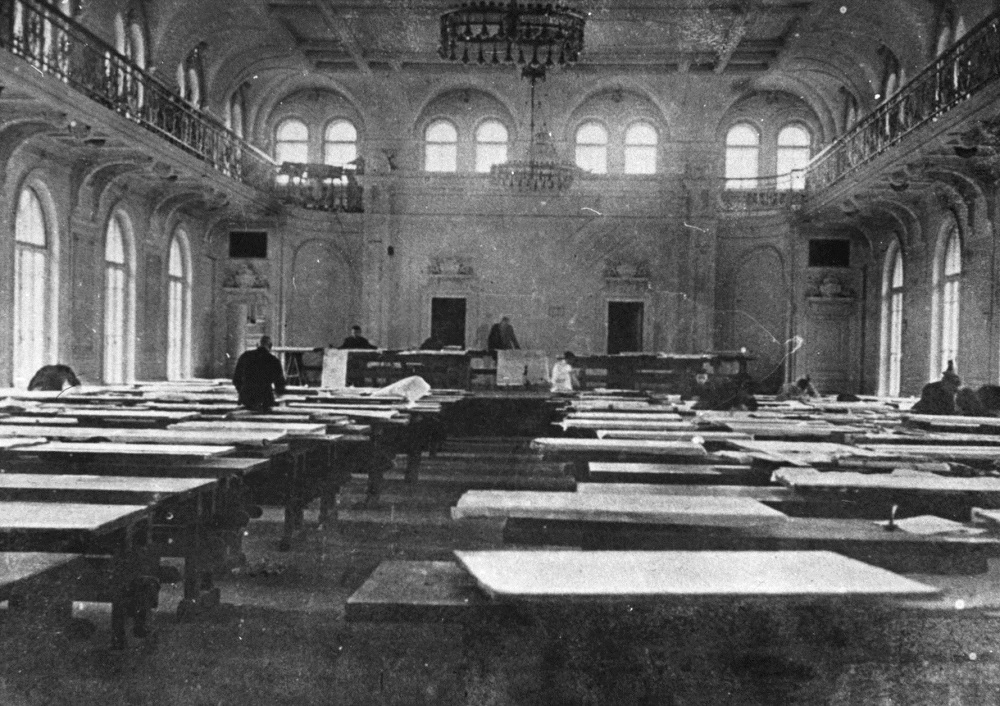
- Computer graphics
- Computer-aided design systems
- Descriptive geometry
- Engineering graphics
- Fundamentals of computer-aided design
- Fundamentals of industrial construction
The position of Institute inspector was abolished. Managing student affairs and supervising training in the workshops was assigned to the inspector of labor, who had two assistants. The supervision of lecturers was entrusted to the dean, who was elected for a period of three years by a curriculum committee consisting of five professors, all senior lecturers, a labor inspector, and an educational inspector. This allowed the Institute to finally receive autonomy from the Ministry of Finance. Professor of mathematics M.A. Krasnovsky was appointed the first dean of the Saint Petersburg Practical Institute of Technology in 1862. In addition, some of the first professors at the Institute were I.A. Vyshnegradsky (mechanics), R.E. Lenz (physics), and F.S. Illish (chemistry).
In 1863, D.I. Mendeleev became a professor of chemistry at SPPIT, which, in accordance with the statute of the Institute at the time, made him the head of the chemical laboratory. He headed the Department of Chemistry for three years. Obtaining a professorship gave D.I. Mendeleev the opportunity to do more research, and he defended his doctoral dissertation in 1865. A copy of D.I. Mendeleev's dissertation with his signature has been preserved as an exhibit in the library of the Institute.
From 1866 to 1872 D.I. Mendeleev taught organic chemistry at SPPIT. In 1869, he formulated the periodic law, forever inscribing his name in the history of science. On par with his exceptional scientific achievements, D.I. Mendeleev was actively engaged in re-equipping laboratories and increasing the quality of education at the Institute. He took part in the work of various commissions created by the Educational Committee, including the development of workshops, summer practice for senior students, drafting rules for obtaining a degree in engineering and technology, and many others.
During his work at SPPIT, D.I. Mendeleev spared no effort for the development of the Institute and used his authority to improve the state of affairs at SPPIT. He succeeded in modernizing the chemical laboratory equipment, purchasing new reagents, and increasing the number of staff. The latter was essential considering that from 1863 to 1872 the number of students at SPPIT nearly tripled. It was D.I. Mendeleev who proposed teaching in laboratory workshops during the second and third years of study instead of the third and fourth. Additionally, a special room was set aside for fourth-year students where they could engage in independent scientific work in their chosen specialty. Thanks to these transformations, the laboratory of the Institute presented 12 chemicals at the Moscow Manufactory Exhibition in 1865, including benzene, aniline, titrated liquids for the analysis of iron, copper, and other compounds. The chemical laboratory at SPPIT became the best educational laboratory in Russia. In addition, D.I. Mendeleev insisted that organic chemistry and analytical chemistry become separate courses.
No longer a professor at the Institute, D.I. Mendeleev chaired the commission for the graduation of SPPIT students in the late 1890s. In 1904, D.I. Mendeleev was elected honorary professor of the Saint Petersburg Practical Institute of Technology.
In 1864, two more professorial departments were opened at SPPIT: the Department of Machine Building and the Department of Chemical Technology headed by N.P. Ilyin.
When seeking employment, graduates of the Institute were assisted by the Russian Technical Society (RTS), established in 1866. There was a prejudice against Russian specialists among entrepreneurs who, reluctant to hire graduates of SPPIT, offered small salaries to those they did employ. Wealthy members of the RTS established several scholarships of their own to support graduates of the Institute during the first years of their work in factories, and many entrepreneurs pledged to hire one graduate of SPPIT every year and offer them generous remuneration.
Among the professors who worked at SPPIT during this period were the distinguished mathematician V.G. Imshenetsky (1832-1892), mineralogist P.V. Eremeev (1830-1899), specialist in the fields of metal machining, mineralogy, and crystallography A.V. Gadolin (1828-1892), and architect B.D. Rozhansky (1840-1886). All these exceptional specialists contributed greatly to the Institute even if it was not their primary place of employment.
During the reorganization of SPPIT, the boarding school, the preparatory class, and the Mining Technical School were abolished. The Institute was divided into two departments: chemical and mechanical.
Only well-prepared applicants who had graduated from gymnasiums and the so-called “real schools” could now enroll in the Institute. If the number of applicants exceeded the number of available seats, the Institute recruited future students through a competition of certificates. The number of available places was set at 130. Following the abolishment of the boarding school, students were paid a scholarship of 20 rubles per month. The number of visiting students was not limited. There were no restrictions on national or confessional grounds when entering the Saint Petersburg Vocational School. Among the students and graduates, there were a significant number of Catholics and Jews. There were especially many Catholics, despite the wary attitude of the official authorities towards them after the Polish uprising of 1863.
A four-year term of study was established. After the second year, the student body was divided between the chemical and mechanical departments. The programs included both general and specialty subjects for each department. Both departments studied the law of God, analytical geometry, drawing and sketching, mineralogy, political economy and industrial statistics of Russia, foreign language, physics, construction, and the technology of processing fibrous substances. Additionally, the Department of Mechanics taught higher mathematics, mechanics, a course on machine building, as well as inorganic chemistry and metallurgy as electives. The Department of Chemistry taught inorganic, organic, and analytical chemistry, chemical technology, metallurgy, as well as electives such as mechanics, anatomy, and physiology of plants and animals in relation to the needs of industry. Mining (until 1868) and a second foreign language were optional for both departments. The curriculum was drawn up by the training committee and approved by the minister of finance. As before, much attention was paid to teaching practical skills. Senior students visited factories and manufactories in the summer, where they got acquainted with the production process and made drawings.
At the end of each academic year, students took transfer exams. After completing their entire academic programs, they took their graduation exams. The 12‑point knowledge assessment system was replaced by a 5‑point one. Those who passed the final exams received various professional titles. Students who received “satisfactory” results became “Technologists of the 2nd Category”, while those who received “excellent” results earned the title of “Technologist of the 1st Category”. Students with poor results in theoretical subjects, but had sufficient practical skills, were given the titles of “Mechanical Master” or “Laboratory Assistant”. A Technologist of the 1st Category had the right to defend a project or an essay on one of the specialty subjects and receive, if approved by the educational committee, the title of “Engineer-Technologist”. From 1868, these graduates were awarded scholarships. In 1870, a graduate badge was created and awarded to graduates who became Engineers and Technologists of the 1st Category.
The first graduation from Saint Petersburg Practical Institute of Technology as a higher educational institution took place in 1865. By this point, the transition period had already ended. Among the graduates of the 1865-1868 academic years were chemists E.A. Vroblevsky (1848-1892) and B.T. Vylezhinsky (1840-1895), statesman I.I. Novinsky (1847-1917), outstanding specialists in technical education I.A. Anopov (1846-1907) and N.I. Tavildarov (1846-1918), gunsmith P.A. Afanasyev (1845-1896), organizer of the production of color smalt for the Church of the Savior on Blood S.P. Petukhov (1842-1912), and deputy director of the Nikolaevskaya railway A.F. Pashkovsky (1847-1884).
In 1867, a new regulation for the Saint Petersburg Practical Institute of Technology was adopted. It limited the number of scholarship recipients to 80 students and allowed for another 50 students to be exempt from tuition fees. The number of tuition-free visiting students was not limited, but it was assumed that a total of 240 would attend theoretical classes and 130 practical classes.
From 1869 to 1878, 23 graduates earned the title of Engineer-Technologist. Among the graduates of this 10-year period were the outstanding chemists V.A. Gemilian (1851-1914), A.A. Kurbatov (1851-1903), and A.A. Letny (1848-1883), physicist P.V. Koturnitsky (1844-1913), economist S.I. Gulishambarov (1849-1915), director of the Putilov plant I.I. Yasyukovich (1847-1914), chief technologist of the Obukhov plant A.A. Rzheshotarsky (1847-1904), discoverer of the “Yarkovsky effect” I.O. Yarkovsky (1844-1902), designers of steam locomotives A.P. Borodin (1848-1898) and N.L. Shchukin (1848-1924), the first director of the Taganrog Technical School N.P. Olovyagin (1850-1918), director of the Odessa Paper Mill N.P. Melnikov (1848–1908?), chief technician of the Saint Petersburg Water Supply Company M.I. Altukhov (1851-1925), member of the technical committee of the Main Quartermaster Department F.E. Kukel (1847–1914?), specialist in theoretical mechanics V.I. Albitsky (1850–after 1918?), and mayor of Astrakhan I.N. Plotnikov (1857–after 1917?).
The most popular Russian writer of the turn of the 19th and 20th centuries, V.G. Korolenko, enrolled in SPPIT but never graduated.
All these transformations and the increased demand for technical education led to a significant increase in the number of students and the need to expand the Institute by building additional buildings and laboratories. In the 1865/66 academic year, 665 students studied at the Saint Petersburg Vocational School, more than half of whom were first-year students. In the early 1870s, the number of students began to increase, with as many as 600 applicants enrolling for the first year of study. Most of them did not transfer to the second year as they did not aspire to higher education, instead hoping that the Institute would teach them sketching skills and basic technical knowledge. Still, the number of scholarships was increased from 50 to 100. First-year students were divided into two groups that studied the same program in parallel. As the number of “real schools” offering secondary technical education grew, admission for the first year of study was reduced. For this reason, entrance exams in mathematics and physics were introduced in 1871.
After the Saint Petersburg Practical Institute of Technology received the status of an institution of higher education, its curriculum was significantly expanded. Gradually, the need for both a more advanced study of some subjects and the introduction of new ones emerged. This need was especially pronounced in relation to the construction and architectural design of industrial buildings. Many students did not have enough time to master the extremely overloaded program, so they continued studying for an additional year, some even longer. In this regard, at the suggestion of the educational committee, a five-year term of study was approved at the Institute, and three new departments were opened in 1872. The teaching of higher mathematics at the Department of Chemistry was also introduced. In 1873, the number of scholarships was increased from 80 to 150, and the number of free seats from 100 to 300. In 1874, the number of first-year students was limited to 250. From 1876, those who successfully completed their five-year programs were awarded the title of Engineer-Technologist.
The Department was founded in 1871 to train engineers and technologists in the field of chemical processing of fossil fuels, and raw plant and animal materials. In 1868, the supervision of the department was entrusted to a graduate of the Institute, B.T. Vylezhinsky, who headed it for more than 20 years. The history of the Department is associated with the names of many talented process engineers and scientists. At the end of the 19th and the beginning of the 20th century, not only did graduates of the Department contribute to the development of the chemical industry, but many worked toward the expansion of oil production and refining, especially in the Caspian Sea Basin. From 1912 to 1917, more than 60 students of the department worked in various districts of Baku and Grozny, managed oil industry enterprises, and occupied member seats on the boards of oil industry societies. For example, many technological engineers such as Professor M.M. Tikhvinsky, I.G. Garsoev, S.S. Tagianosov, and E.K. Petrov worked in the Nobel Brothers Partnership. Others, like A.A. Paronyan, were employed in the Caspian Partnership, or like G.G. Kyandzhuntsev in the Moscow-Caucasian Society. G.M. Liazanova, A. Nazarov, Moussa-Nagieva, F.B. Rustambekov, and many others worked for the Russian Oil Society. The department conducted research work on coking coal in Donetsk and other basins to obtain benzene, toluene, and ammonia and to obtain nitric acid from ammonia. In Tula, P.A. Solodovnikov (who had graduated from the department in 1907) headed a large-scale investigation (1928) of coal gasification in the Moscow region, which served to create the Tula-Moscow gas transmission project. Today, the Department of Technology of Petrochemical and Coal Chemical Industries prepares bachelors and masters in the field of the technology of chemical processing of hydrocarbon raw materials such as oil, gas, and coal into valuable products for the chemical industry and the national economy. It is headed by Doctor of Chemical Sciences Associate, Professor V.V. Potekhin.
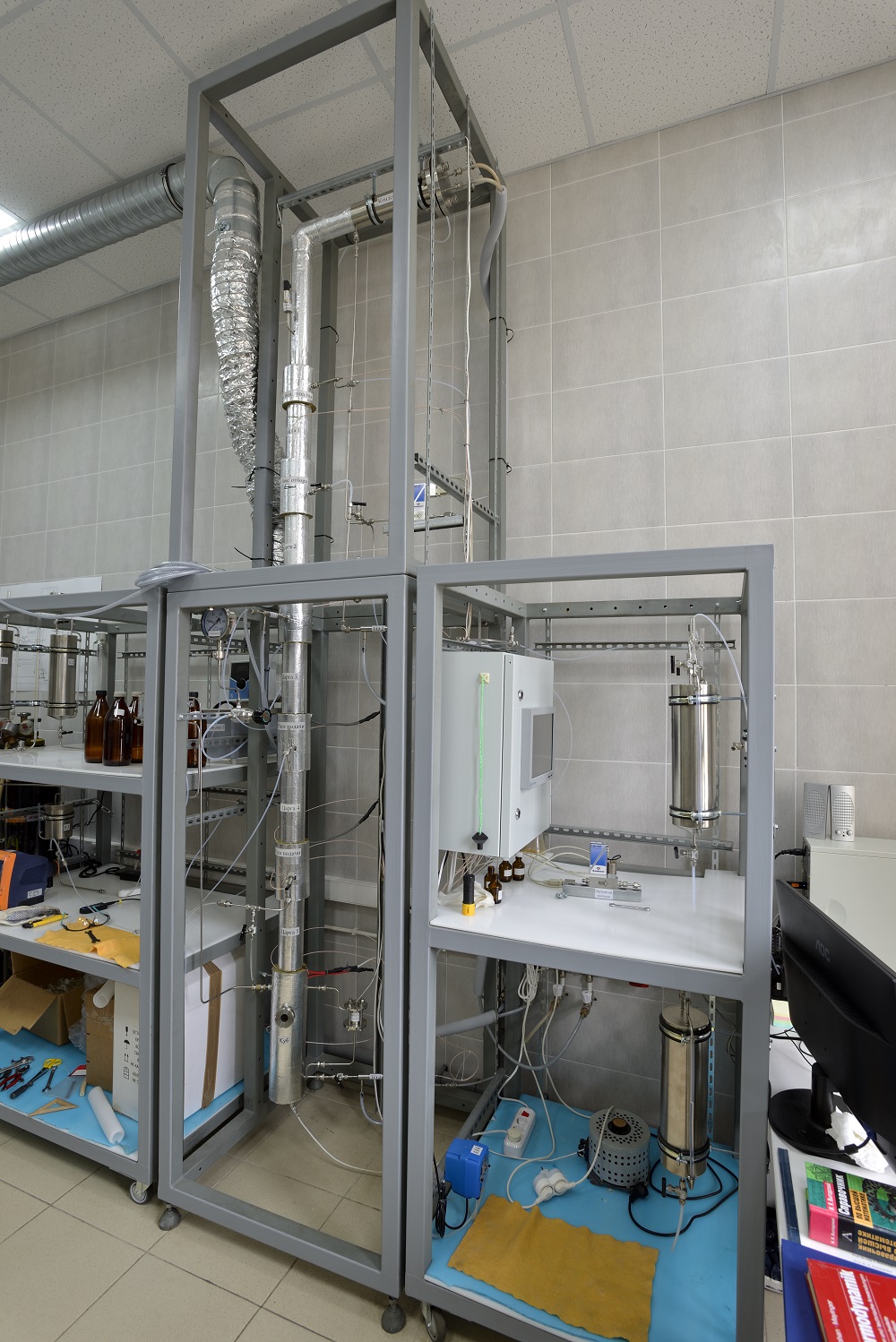
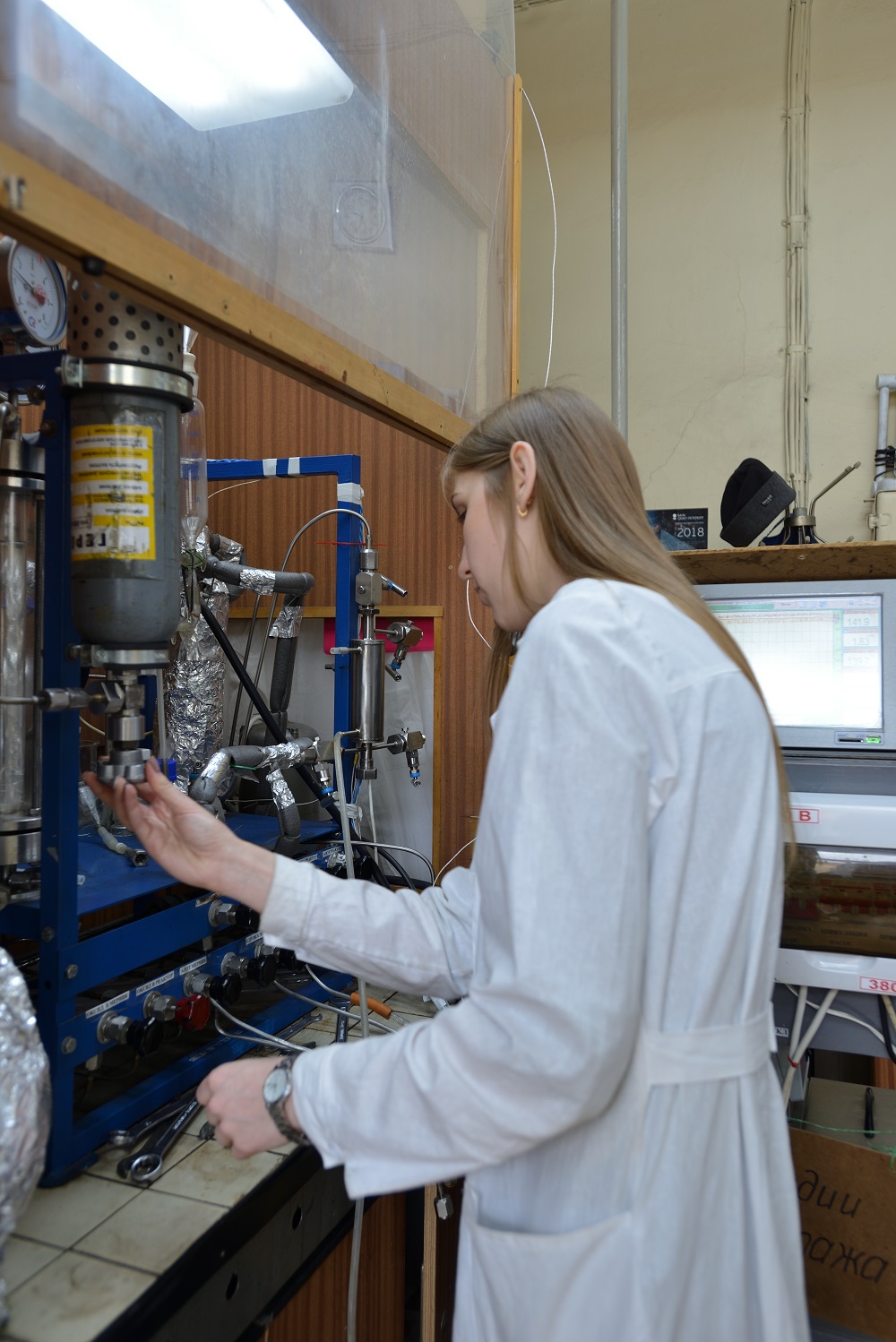
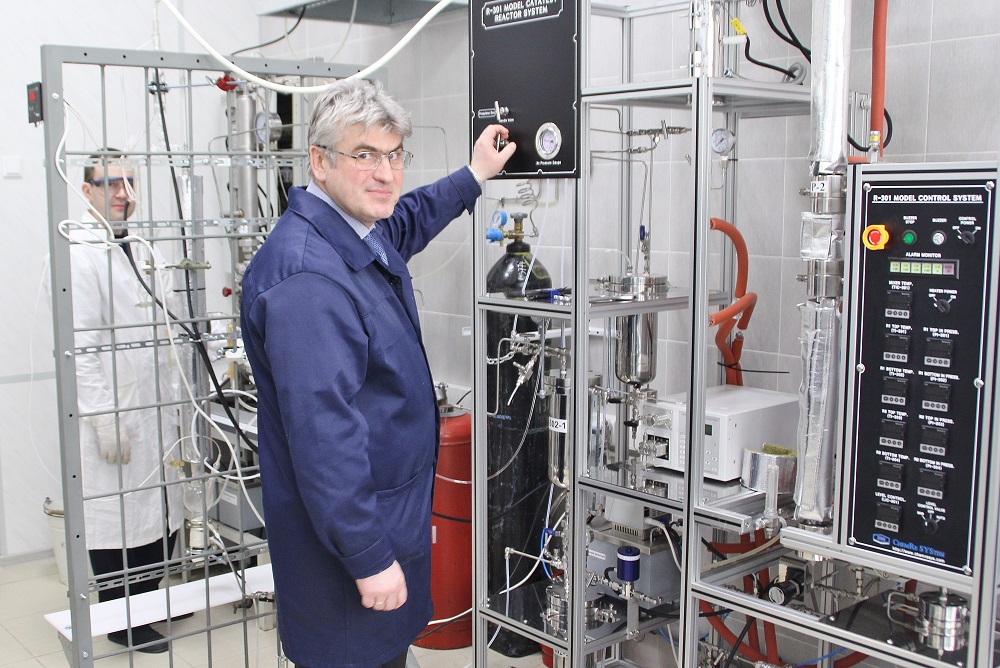
- Catalytic processes of processing of natural energy carriers
- Chemical technology of fuels and carbon materials
- Chemistry and technology of organic substances
- Ecology of production of organic synthesis products and processing of combustible minerals
- Experimental methods for studying the processes of organic synthesis and processing of natural energy carriers
- Fundamentals of design and calculation of equipment technology of organic substances
- General factory management and organization of plant design
- Heterogeneous-catalytic processes in organic synthesis
- Metrology, standardization and certification
- Natural energy carriers and carbon materials
- Processes of separation and purification of organic substances
- Technology of petrochemical synthesis products
- Theoretical foundations of chemical technology of fuel and carbon materials
- Theory of chemical and technological processes of organic synthesis
- Thermodynamic analysis of chemical processes of organic synthesis
In 1871, at the initiative of I.A. Vyshnegradsky, the “Pentagon Society” was established in SPPIT as a community of researchers and specialists for the exchange of thought and experience regarding the latest developments in science. Apart from its founder, the Pentagon Society included many professors. It played an important role in the advancement of applied mechanics. During the 1873 World's Fair in Vienna, SPPIT presented two large steam cylinders with accessories in assembled and disassembled forms, collections of pattern models, bearings, brackets, and suspensions, accompanied by a collection of connecting couplings for shafts, a parallel-sliding vise, a circular saw, as well as drilling, turning, and universal planing machines. For the entirety of the exhibited works, the Institute was awarded the Medal of Merit and the Medal of Progress.
In 1877, the publication of the “News of the Institute of Technology” yearbook began. Today, it is one of the leading domestic publications in the field of chemistry and chemical technology, issued several times a year.
In 1878, graduates of the Institute earned the right to design and construct factory and manufactory buildings and to supervise construction works for the Ministry of Railways.
In 1878, the Institute celebrated its 50th anniversary. The date on which the decree was signed was adopted as the first day of the Institute’s existence instead of the actual opening date. At the same time, the 25th anniversary was celebrated in 1856. Since that time, 1828 is considered the year of the Institute’s foundation.
From 1879 to 1896, many distinguished scientists graduated from SPPIT, including outstanding chemists L.G. Bogaevsky (1858-1911), V.N. Jones (1865-1931) and A.A. Yakovkin (1860-1936), the first laureate of the L.E. Nobel Prize and gold medal A.I. Stepanov (1866-1937), future directors of Technolozhka A.A. Voronov (1861-1938) and D.S. Zernov (1860-1922), the founder of the dynamics of living organisms Ya.I. Grdina (1871-1931), specialist in internal combustion engines and director of the Electrotechnical Institute N.A. Bykov (1862-1939), one of the greatest Russian power engineers R.E. Klasson (1868-1926), locomotive building engineers P.M. Mukhachev (1861-1935) and B.S. Malakhovsky (1867-1934), specialist in the field of textile production N.P. Langova (1860-1920), deputies of the State Duma A.S. Lomshakov (1870-1960) and V.V. Milyutin (1873–after 1934), the last Minister of Railways of the Russian Empire Eduard Bronislavovich Krieger-Voynovsky (1864-1933), specialist in steam turbines A.A. Radzig (1869-1941), outstanding hydrologist E.O. Oppokov (1869-1937), Jewish public figures G.E. Weinstein (1860-1929) and V.I. Temkin (1861-1927), specialist in factory legislation A.N. Bykov (1860-1919), head of the Industry Department at the Ministry of Trade V.P. Litvinov-Falinsky (1868-1929), railway specialist P.S. Seleznev (1864-1925), successful entrepreneurs R.D. Novinsky (1862–after 1906) and I.N. Yalovikov (1862– after 1913), specialist in insurance and fire safety G.S. Eismont (1861-1908), economist and founder of the Institute of Scientific Management in Poland K.K. Adamecki (1866-1933), composer A.G. Shaposhnikov (1887-1967), and the first official representative of Soviet Russia in the USA L.K. Martens (1874-1948).
From 1887, those studying at the Institute officially started to be referred to as students.
Graduates of the Institute were employed in various educational institutions such as the Moscow Higher Technical School, Higher Women's Technical School in Saint Petersburg, the Moscow Institute of Chemical Technology, the Kharkov and Tomsk Technological Institutes, the Don, Kiev, and Saint Petersburg Polytechnic Institutes.
Despite the high demand for technologists in Russia (as evidenced by the establishment of the Institute of Technology in Kharkov in 1885), the regulation of 1887 ensured a reduction in the number of first-year enrollments. This was caused by fear of possible political manifestations and student unrest, among other things. However, after a few years, the Institute again increased its student enrollment rates.
Although at its foundation, the Institute primarily enrolled students from the lower strata of society, it quickly became one of the centers of student political associations. The first student unrest at the Institute took place in the 1860s, but its main targets were academic issues and internal regulations. By the 1870s, however, student associations and gatherings had become more political.
In 1874, the Institute’s administration tried to close the Institute temporarily to “pacify the students”, which stirred protests among hundreds of technology students. Numerous protestors were arrested, including some members of the Narodnaya Volya organization. As an educational institution, the Institute was authorized to order print materials and to publish its own. Therefore, bypassing censorship, illegal publications, including those related to politics and social issues, accumulated in the library of the Institute.
Technology students, whose training focused on production technologies, sought to spread their political views among the workers in Saint Petersburg by organizing ideological associations in factories. One of the best-known student associations of the late 1880s and early 1890s was the group of M.I. Brusnev, who was an SPPIT student. From 1889, members of the group, all of whom were university students, disseminated propaganda in their circles. The Brusnev group organized ideological circles among workers, notably on the premises of weaving factories located on the Obvodny Canal Embankment. Another technology student, L.B. Krasin, also played a prominent role in organizing such groups. The Brusnev group ceased to exist in 1892 when its members were arrested, expelled from the Institute, and later exiled from Saint Petersburg.
Despite political belligerence on the part of students and retaliatory repressions on the part of the authorities, Technolozhka remained a stronghold of freedom of thought. During their studies, students continued to intern in factories and manufactories and, consequently, had every opportunity to socialize with workers.
Reactionary policy in Russia at the end of the 19th century led, among other things, to increased censorship. At SPPIT, however, the quality of education remained a priority, which required constant replenishment of the Institute's library with the latest domestic and foreign technical literature. The Institute was entitled to publish without passing censorship as well as to order any publications and manuscripts from abroad without restrictions. In addition, SPPIT was able to order foreign technical equipment duty‑free.
Founded in 1884, the Department is one of the oldest chemical technology departments among technical universities in Russia. It is the direct successor to the dyeing and coloristics workshops that were established as part of the Institute six years after its foundation and operated under the supervision of a chemistry professor. The Department was renamed several times. Many of its achievements are associated with the name of an outstanding scientist, Full Member of the USSR Academy of Sciences A.E. Poray-Koshits, who headed the Department from 1911 to 1949. During its long history, any challenges faced by the Department of Dyes were successfully tackled by generations of teachers, researchers, and graduate students under the guidance of venerated scientists who formed its backbone. The coloristics school of the Department of Dyes made significant contributions to the study of the properties of synthetic dyes and the development of the physical chemistry of dyeing. The Department conducted extensive research in the field of light fastness of dyes and developed recipes for dyeing various substrates. Notably, original methods of light-resistant coloring of natural amber were developed for use in the “Amber Room” in the Catherine Palace in Pushkin. For a long time, thousands of process engineers, hundreds of Candidates of Sciences and dozens of Doctors of Sciences were trained at the Department. Graduates of the Department of Dyes, who undergo thorough training and acquire in-depth chemical knowledge, had and still have a significant impact on the development of the fine organic synthesis industry, chemical sciences, and chemistry education in Russia. They work as university teachers, researchers of scientific organizations, technologists, chief specialists, and managers at enterprises producing aniline, chemical-pharmaceutical, and other branches of the chemical industry. A number of graduates of the Department have become successful businessmen. Today, the Department is headed by Doctor of Chemical Sciences, Professor S.M. Ramsh.
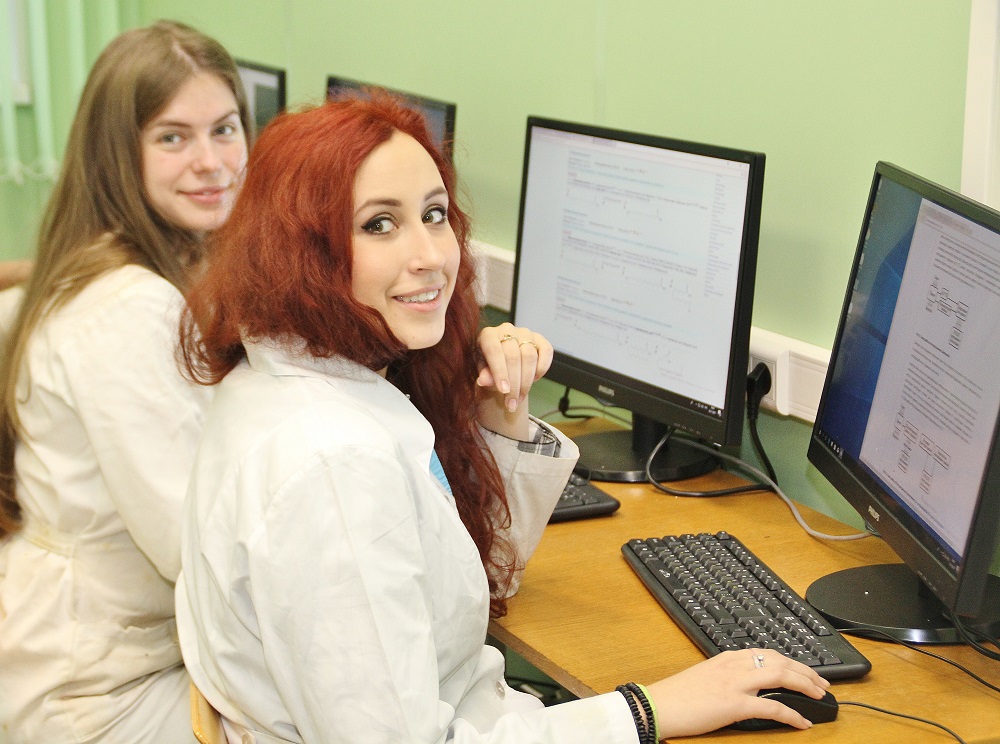
- Additional courses on fine organic synthesis chemistry
- Application of fine organic synthesis products
- Applied organic chemistry
- Chemistry and technology of fine organic synthesis
- Chemistry and technology of organic dyes
- Fundamentals of chemical informatics
- Fundamentals of design and equipment of organic synthesis enterprises
- Introduction to photochemistry
- Methods of analysis of organic compounds
- Modern materials and devices based on organic dyes and phototropic compounds
- Modern methods and physicochemical bases of coloring materials
- Modern methods of NMR spectroscopy of organic compounds
- Modern problems of chemistry and chemical technologies
- Structure and reactivity of heteroaromatic compounds
- Theory of chemical and technological processes of fine organic synthesis
The Institute closely observed the development of technical education and industry abroad. In 1893, the Institute's employees were sent to participate in the World Columbian Exposition in Chicago. Their observations of the American education system would be used for further development of the Institute.
In 1888, using its right to elevate scientists to the title of honorary engineer-technologist, the Institute’s educational committee awarded several specialists: owner of the textile factory A.I. Baranov, owner of the cast-iron foundry and mechanical plant F.K. San Galli, owner of the textile factory and chemical plant K.Ya. Pal, director of the Baltic Shipbuilding plant M.I. Kazi, and a graduate of the Institute, the technologist N.N. Novokreshenykh. Later, the title of honorary engineer-technologist was awarded to former Finance Minister S.Y. Witte, Minister of Railways M.I. Khilkov, British citizen K. Rayner, and the manager of the Kulebak plant.
Professors and graduates of the Saint Petersburg Practical Institute of Technology collaborated with technical periodicals, not only by publishing their research but also as editors and founders of new journals. A.P. Borodin (1848-1898) was the editor-in-chief of the journal Engineer, P.V. Koturnitsky (1844-1913) was an editor of the Bulletin of the Society of Technologists, N.P. Melnikov (1848-1908?) acted as editor of the Technical Illustrations magazine, and G.N. Shveder (Gerstfeld) (1870-1942) was a secretary of the editorial board of the Electricity magazine.
In 1896, the Institute was renamed the “Institute of Technology of Emperor Nicholas I”. For this occasion, a special badge was instituted for graduates of the Institute. The renaming was timed to coincide with the 100th anniversary of the birth of the emperor who had issued the decree on the foundation of the Institute.
In fact, as the word “practical” disappeared from the name of the Institute, it came to reflect the essence of the changes that had occurred in the institution since its foundation. Originally a technical school, the Institute transformed into a full-fledged institution of higher education offering advanced scientific studies.




















